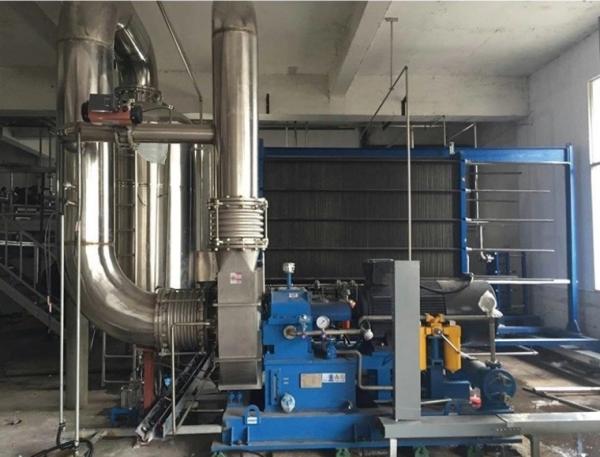| Sign In | Join Free | My himfr.com |
|
| Sign In | Join Free | My himfr.com |
|
| Ask Lasest Price | |
| Brand Name : | TY |
| Model Number : | plate |
| Price : | USD10000 |
| Payment Terms : | D/P, T/T, Western Union |
| Supply Ability : | 100 |
| Delivery Time : | 1-2months |
Food Processing Evaporating System MVR Evaporator

By analyzing material properties and process parameters, the system
uses: four-effect plate-type downstream design, the process flow is
as follows:
The material conveyed from the preceding stage is preheated by the
feed preheating system to the boiling point temperature of the
first effect evaporator ZF01, and enters the first effect
evaporator ZF01, which is heated and vaporized by the heating steam
on both sides in the evaporator, and then The mixture outlet of the
evaporator is sprayed at a high speed in the form of a vapor-liquid
mixture, and the tangential line enters the material inlet of the
primary cyclone separator XFQ1. In the cyclone separator, due to
the centrifugal force, the droplets are sucked to the wall of the
cylinder and are collected by gravity. The bottom of the separator
is then pumped out by the first material pump CB01 to the next
stage evaporator ZF02, and the vapor phase is spirally raised. The
small amount of droplets trapped by the top is captured by the top
set of the juice trapping device and returned to the bottom of the
tank. The heating chamber which is discharged into the lower stage
evaporator ZF02 from the air outlet at the top of the separator
serves as a heating heat source.
Similarly, the primary concentrated material sent from CB01 to the
second-effect evaporator ZF02, the secondary steam generated by the
first-effect evaporator ZF01 continues to be heated and vaporized
and boiled, and enters the two-effect cyclone XFQ2 for centrifugal
separation, and the liquid phase is pumped by the product. The CB02
is taken out to the next stage evaporator ZF03, and the vapor phase
is passed to the heating chamber of the next stage evaporator ZF03
as a heating source.
Similarly, the secondary concentrated material sent from CB02 to
the second-effect evaporator ZF03 is heated by the secondary steam
generated by the two-effect evaporator ZF02 to vaporize and boil,
and enters the three-effect cyclone XFQ3 for centrifugal
separation. The pump CB03 is pumped out to the next stage
evaporator ZF04, and the vapor phase is passed to the heating
chamber of the next stage evaporator ZF04 as a heating source.
Similarly, the three concentrated materials sent from CB03 to the
second-effect evaporator ZF04, the secondary steam generated by the
three-effect evaporator ZF03 continues to be heated and vaporized
and boiled, and enters the four-effect cyclone XFQ4 for centrifugal
separation, and the liquid phase is pumped by the product. The CB04
is taken out, and the qualified material is sent to the product
storage tank through the concentration or density detection, and
the unqualified product is returned to the incoming material tank;
the vapor phase enters the steam inlet of the condenser LNQ.
The secondary steam and non-condensable gas entering the condenser
LNQ are cooled by the circulating cooling water of the process to
be condensed and cooled, and then enter the condenser steam-water
separation tank FLGL. The liquid phase is extracted by the
condenser condensate pump NBL at the bottom of the separation tank,
The condensate is withdrawn from the top of the separation tank by
a vacuum system. The process circulating cooling water is provided
by the user, and the user ensures that the water temperature and
flow rate meet the requirements of use.
The establishment and maintenance of the system vacuum is completed
by a set of water ring vacuum pumps. The working fluid of the
vacuum pump is provided by the user, generally clean and
non-corrosive 25 ° C normal temperature cold water.
In order to save energy and increase operating costs, the system is
optimized as follows:
1. The feed preheating system adopts three-stage design: preheater
A (end-effect waste steam preheating) → preheater B (mixed
condensate preheating) → preheater C (fresh steam preheating)

|